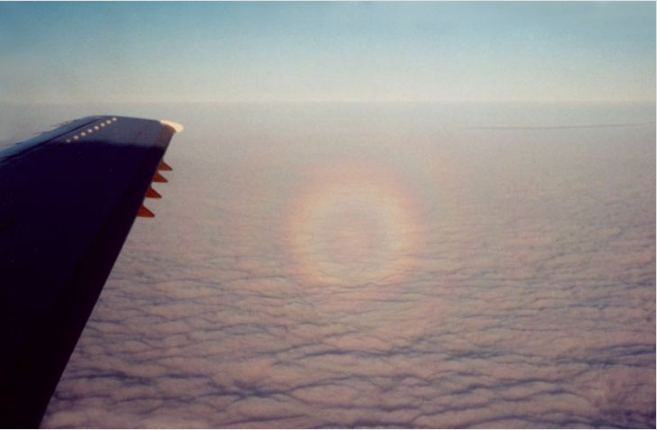Glory from aircraft
The Glory Phenomenon: A Spectacular Optical Display from Aircraft
The glory is a mesmerizing atmospheric optical phenomenon that often captivates the eyes of those lucky enough to witness it. This ethereal spectacle, also known as the "glory of the pilot," occurs when sunlight interacts with tiny water droplets or ice crystals in the atmosphere. While it is commonly observed from the ground, it can also be seen from aircraft flying above cloud layers. In this article, we will delve into the fascinating details of the glory phenomenon as seen from aircraft and explore the science behind its formation.
What is a Glory?
A glory is a series of concentric rings of vibrant colors surrounding the shadow of an aircraft cast onto a cloud layer below. The rings are caused by the diffraction and interference of sunlight as it interacts with the droplets or crystals in the cloud. These rings often appear as a pale, circular halo with several colored rings on the inside. The colors of the glory are typically arranged in the order of red on the outer edge, followed by orange, yellow, green, blue, indigo, and violet towards the center.
Viewing the Glory from Aircraft
When viewing a glory from an aircraft, the observer must be situated between the sun and the cloud layer below. As the aircraft casts its shadow onto the cloud deck, the glory forms around this shadow. However, unlike when viewing from the ground, the shadow of the aircraft is no longer visible due to the distance between the aircraft and the cloud layer. This unique perspective offers a breathtaking view of the glory phenomenon, seemingly painting the sky with its vibrant colors.
Formation of a Glory
The formation of a glory involves several optical processes. As sunlight passes through the cloud droplets or ice crystals, it undergoes both refraction and reflection. Refraction occurs when light changes direction as it passes from one medium to another, such as from air to water. Reflection, on the other hand, is the bouncing back of light when it encounters a surface. These combined processes cause the light to scatter and interfere with each other, leading to the formation of the glory rings.
Understanding Diffraction and Interference
Diffraction is a phenomenon that occurs when light waves encounter an obstacle or aperture, causing them to bend and spread out. In the case of a glory, the cloud droplets or ice crystals act as tiny obstacles, diffracting the sunlight. The diffracted light waves then interfere with each other, resulting in constructive and destructive interference patterns. This interference creates the distinct rings of colors seen in a glory.
The Role of Droplet Size
The size of the cloud droplets or ice crystals plays a crucial role in the formation of a glory. Smaller droplets tend to produce larger and more vibrant glories, while larger droplets may result in weaker or less defined glories. This size dependence is due to the relationship between droplet size and the diffraction and interference patterns formed by the scattered light. The precise conditions required for a glory to form can vary, making each sighting a unique and awe-inspiring experience.
Other Factors Influencing Glory Appearance
In addition to droplet size, other factors can influence the appearance of a glory from aircraft. The altitude and angle of the aircraft, as well as the position of the sun in relation to the observer and the cloud layer, all play a role in shaping the glory's characteristics. Different atmospheric conditions, such as variations in humidity and cloud composition, can also impact the visibility and intensity of the glory.
Similar Optical Phenomena
While the glory is a remarkable sight, it is not the only optical phenomenon that can be observed from aircraft. Pilots and passengers may also witness other captivating atmospheric displays, including:
- Brocken spectre: A similar phenomenon to the glory, the Brocken spectre occurs when an observer's shadow is cast onto a cloud or fog bank, creating a halo-like ring around their shadow.
- Sundogs: Also known as parhelia, sundogs are bright spots of light that appear on either side of the sun. They are caused by the refraction and reflection of sunlight by ice crystals in the atmosphere.
- Rainbows: Although rainbows are more commonly seen from the ground, they can also be observed from aircraft under the right conditions. Rainbows form when sunlight is refracted, reflected, and dispersed by raindrops in the atmosphere.
Awe-Inspiring Moments in the Sky
The glory phenomenon, with its vibrant rings of colors encircling the shadow of an aircraft, is a true spectacle of nature. Witnessing this phenomenon from the unique vantage point of an aircraft offers a perspective that showcases the beauty and complexity of our atmosphere. As we continue to explore the wonders of the sky, may we never cease to be amazed by the breathtaking optical displays that nature has in store for us.

The clouds forming this four ringed glory are so far below the aircraft that its shadow is no longer visible. Photographed by astronomer and science writer Jim Kaler (site ) of Illinois. ©James B. Kaler, shown with permission.
Note: this article has been automatically converted from the old site and may not appear as intended. You can find the original article here.
Reference Atmospheric Optics
If you use any of the definitions, information, or data presented on Atmospheric Optics, please copy the link or reference below to properly credit us as the reference source. Thank you!
-
<a href="https://atoptics.co.uk/blog/glory-from-aircraft-2/">Glory from aircraft</a>
-
"Glory from aircraft". Atmospheric Optics. Accessed on November 26, 2024. https://atoptics.co.uk/blog/glory-from-aircraft-2/.
-
"Glory from aircraft". Atmospheric Optics, https://atoptics.co.uk/blog/glory-from-aircraft-2/. Accessed 26 November, 2024
-
Glory from aircraft. Atmospheric Optics. Retrieved from https://atoptics.co.uk/blog/glory-from-aircraft-2/.